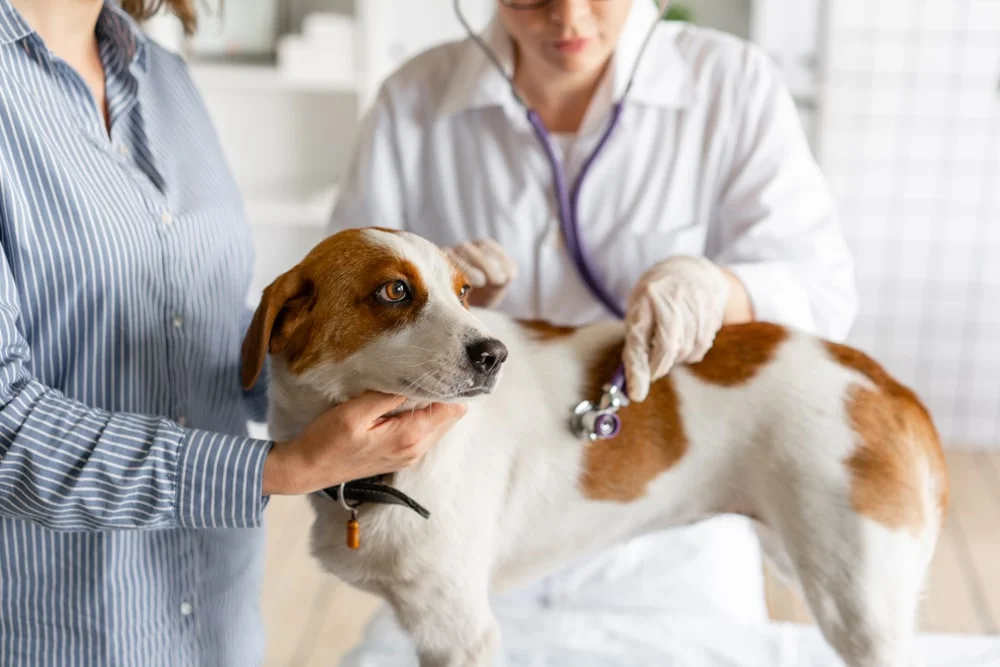PET HEALTH
Why Is My Dog Throwing Up?
Your dog might be throwing up because they ate something they shouldn’t have, something that didn’t agree with them, or they ingested their dog food too quickly. Vomiting in dogs can be common and may not be a cause for concern. But in some cases, it might signal a more serious condition that your veterinarian can address.1
MetLife Pet Can Help Cover Costs for Dog Illnesses
Why Does My Dog Keep Throwing Up?
Dogs throw up for a variety of reasons. Vomiting helps the body get rid of harmful substances or toxins, so it’s important to monitor your dog for other symptoms if they throw up for more than 1 or 2 days.1,2
Vomiting in dogs is often considered acute or chronic. Acute vomiting happens suddenly and is a short-term issue — often due to something minor, like eating too fast. Chronic vomiting occurs regularly over at least 7 days and could be due to an underlying cause.2
If your dog is known for getting into things they shouldn’t, they might have eaten something that upset their stomach. But if you suspect they’ve ingested something toxic or may have an underlying illness — such as a gastrointestinal disorder — it’s a good idea to consult your veterinarian right away. Let’s take a look at some of the reasons your dog might be throwing up.
Dietary and environmental causes
Some of the most common possible causes of vomiting in dogs stem from a sudden change in your pup’s diet or their curious nature. These factors can upset their stomach and lead to vomiting:1,2,3
- Changing their diet too quickly
- Stress
- Food allergies
- Eating garbage or spoiled food
- Ingesting foreign objects (toys, bones, or pieces of fabric)
- Eating certain insects or toxic plants
Medical conditions
Sometimes, throwing up can be caused by a more serious medical condition. Some examples of underlying health issues that can lead to vomiting in dogs include:1,2,3
- Gastrointestinal (GI) tract infection
- Intestinal parasites
- Pancreatitis (inflammation of the pancreas)
- Gastroenteritis (swelling of the stomach or intestines)
- Inflammatory bowel disease (IBD)
- Acid reflux (GERD) or gastric ulcers
- Kidney or liver disease or failure
- Cancer
Other causes
In some cases, dogs may throw up because of external triggers, including the following:1,2,3
- Reaction to certain medications
- Injected, inhaled, or ingested poisons
- Viral infections (like parvovirus)
Dog Vomiting vs. Regurgitating
It’s important to know whether your dog is actually vomiting or simply regurgitating their food. The causes of vomiting and regurgitation are different, so they require different treatments.1
Before vomiting, your dog may display one or more signs of nausea, like restlessness, excessive lip licking, drooling, or swallowing repeatedly. During vomiting, the abdominal muscles contract, which leads to a forced ejection of the stomach contents. Vomiting can happen at any time.1
Meanwhile, regurgitating or gagging can occur when undigested food — food that hasn’t made it to the stomach yet — moves back up the esophagus and is ejected. This tends to happen shortly after eating or drinking and doesn’t involve forceful stomach contractions.1
Different Types of Vomit and What They Mean
While looking at your dog’s vomit can be an unpleasant experience, the color and texture can help you and your vet figure out what’s wrong. Here’s what it could mean:3
- Foamy: If your dog is throwing up white foam, it could indicate acid reflux.
- Bloody: There may be bleeding in the digestive tract.
- Coffee ground texture: This usually indicates bleeding in the lower GI tract.
- Brown: This could be food or feces they just ate, or digested blood.
- Mucusy, moldy, or slimy: This can be due to parasites, eating garbage, or drinking contaminated water.
- Yellow: Your dog throwing up yellow bile can indicate they have an empty stomach.
- Clear: Usually, this is because your dog drank too much water too quickly.
- Green: Your dog may have been eating grass, or there’s excess bile in their stomach.
When Should I Be Worried About My Dog Throwing Up?
If your dog only vomits occasionally, displays no other symptoms, and continues to eat normally, you probably don’t need to be overly concerned.1
But if your dog’s vomiting is accompanied by blood, diarrhea, fever, a swollen abdomen, or lasts more than 1 or 2 days, it’s a good idea to contact your vet. These can be symptoms of a more serious health condition.1
Keep an eye on other symptoms as well, such as dehydration, changes in appetite, abdominal pain, weight loss, increased thirst, or lethargy.1,2 Noticing these details can help your vet diagnose the cause of your dog’s vomiting more quickly.
How To Treat Vomiting in Dogs
If your pup’s vomiting is accompanied by concerning symptoms, like those mentioned above, a trip to the vet can help figure out the problem. They may run diagnostics — like blood work, urinalysis, biopsies, X-rays, or ultrasounds — and offer guidance on how to care for your pup at home.1
Your dog’s treatment plan depends on the cause. If they’re in distress, your vet may first focus on supportive care, such as fluid therapy and medications that provide more immediate relief.3
For minor upsets and dietary indiscretions, your vet may recommend feeding your dog a bland diet — usually small portions of plain cooked chicken and rice — for a few days before gradually reintroducing their normal food.3 If necessary, your vet may prescribe medications to control nausea, support digestive health, and reduce inflammation.1
Underlying causes like parasites, infections, ulcers, and other medical conditions will likely be treated with medications and could also involve special diets to help manage conditions.1,2 Surgery may be required to investigate further, remove foreign objects, or repair any GI tract damage.2
Home remedies for an upset stomach
Ask your vet for their recommendation, but you can also try gentle home remedies like ginger, pumpkin puree, and honey to help soothe your pup’s stomach. To help prevent dehydration, offer fresh water or ice chips in small amounts.1,3
MetLife Pet Insurance Can Help Cover Dog Illness Costs
Whether your dog’s vomiting was caused by something they ate or an underlying health problem, paying a visit to your vet may be the best course of action if it persists.
Pet insurance from MetLife Pet may help cover the cost of veterinary care if your dog is throwing up or feeling unwell. With reimbursements up to 90% on things like diagnostics, vet exams, prescriptions, and more, you can be more financially prepared for the unexpected.4 See your plan options and personalized rates by getting a free quote today.


